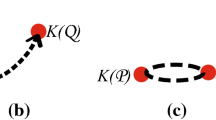Abstract
Relationships between information systems are very important topics in the field of artificial intelligence. The concept of homomorphisms is an effective mathematical tool to study relationships between information systems. A knowledge base is a special relation information system. This paper investigates invariant characteristics of knowledge bases under the homomorphism. The fact that knowledge bases themselves are invariant and inverse invariant under the homomorphism is firstly proved. Next, some invariant characteristics and inverse invariant characteristics under the homomorphism, such as the dependency of knowledge bases, knowledge reductions, coordinate families and necessary relations, are obtained based on this fact. Finally, lattice characteristics of the dependency of knowledge bases are given. These results will be significant for establishing a framework of granular computing in knowledge bases.
Similar content being viewed by others
References
Davey BA, Priestley HA (1990) Introduction to lattices and order. Cambridge University Press, Cambridge
Grzymala-Busse JW (1986) Algebraic properties of knowledge representation systems. In: Proceedings of the ACM SIGART international symposium on methodologies for intelligent systems, Knoxville, pp 432–440
Grzymala-Busse JW, Sedelow WA (1988) On rough sets, and information system homomorphism. Bull Polish Acad Technol Sci 36(3–4):233–239
Kryszkiewicz M (2001) Comparative study of alternative types of knowledge reduction in inconsistent systems. Int J Intell Syst 16:105–120
Levy Y, Rousset MC (1998) Verification of knowledge bases based on containment checking. Artif Intell 101:227–250
Liang J, Xu Z (2002) The algorithm on knowledge reductionion in incomplete information systems. Int J Uncertain Fuzziness Knowl Based Syst 24(1):95–103
Li D, Ma Y (2000) Invariant characters of information systems under some homomorphisms. Inf Sci 129:211–220
Pawlak Z (1991) Rough sets: theoretical aspects of reasoning about data. Kluwer, Dordrecht
Pawlak Z, Skowron A (2007) Rudiments of rough sets. Inf Sci 177:3–27
Pawlak Z, Skowron A (2007) Rough sets: some extensions. Inf Sci 177:28–40
Pawlak Z, Skowron A (2007) Rough sets and Boolean reasoning. Inf Sci 177:41–73
Pawlak Z (1982) Rough sets. Int J Comput Inform Sci 11:341–356
Pedrycz W, Vukovich G (2000) Granular worlds: representation and communication problems. Int J Intell Syst 15(11):1015–1026
Qian Y, Liang J, Dang C (2009) Knowledge structure, knowledge granulation and knowledge distance in a knowledge base. Int J Approx Reason 50:174–188
Skowron A, Rauszer C (1992) The discernibility matrices and mappings in information systems. In: Slowinski R (ed) Intelligent decision support. Handbook of applications and advances of the rough set theory. Kluwer, Dordrecht, pp 331–362
Wang C, Chen D, Sun B, Hu Q (2012) Communication between information systems with covering based rough sets. Inf Sci 216:17–33
Wang C, Chen D, Wu C, Hu Q (2011) Data compression with homomorphism in covering information systems. Int J Approx Reason 52:519–525
Wang C, Chen D, Zhu L (2009) Homomorphisms between fuzzy information systems. Appl Math Lett 22:1045–1050
Wu W, Zhang M, Li H, Mi J (2005) Knowledge reductionion in random information systems via Dempster-Shafer theory of evidence. Inf Sci 174:143–164
Wang C, Wu C, Chen D, Du W (2008) Some properties of relation information systems under homomorphisms. Appl Math Lett 21:940–945
Wang C, Wu C, Chen D, Hu Q, Wu C (2008) Communicating between information systems. Inf Sci 178:3228–3239
Yao YY (1998) Constructive and algebraic methods of the theory of rough sets. Inf Sci 109:21–47
Zhao J, Liu L (2011) Construction of concept granule based on rough set and representation of knowledge-based complex system. Knowl Based Syst 24:809–815
Zhang W, Mi J, Wu W (2003) Knowledge reductions in inconsistent information systems. Int J Intell Syst 18:989–1000
Zhang W, Qiu G (2005) Uncertain decision making based on rough set theory. Tsinghua University Publishers, Beijing
Zhu P, Wen Q (2010) Some improved results on communication between information systems. Inf Sci 180:3521–3531
Zhu P, Wen Q (2011) Homomorphisms between fuzzy information systems revisited. Appl Math Lett 24:1548–1553
Zhang W, Wu W, Liang J, Li D (2001) Rough set theory and methods. Chinese Scientific Publishers, Beijing
Acknowledgments
The authors would like to thank the editors and the anonymous reviewers for their valuable suggestions which have helped immensely in improving the quality of this paper. This work is supported by the National Natural Science Foundation of China (11461005, 11371130, 11371003, 11201490, 11401052), the Natural Science Foundation of Guangxi (2014GXNSFAA118001, 2012GX NSFGA060003), Guangxi University Science and Technology Research Project (KY2015YB075, KY2015YB081), Special Funds of Guangxi Distinguished Experts Construction Engineering and Key Laboratory of Optimization Control and Engineering Calculation in Department of Guangxi Education.
Author information
Authors and Affiliations
Corresponding author
Rights and permissions
About this article
Cite this article
Li, Z., Liu, Y., Li, Q. et al. Relationships between knowledge bases and related results. Knowl Inf Syst 49, 171–195 (2016). https://doi.org/10.1007/s10115-015-0902-z
Received:
Revised:
Accepted:
Published:
Issue Date:
DOI: https://doi.org/10.1007/s10115-015-0902-z




